Kayaking Stability Tips and Guide
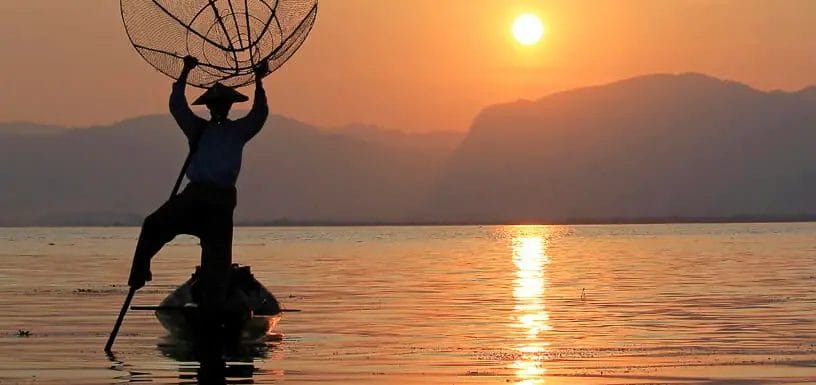
One of the most frequent questions I encounter about kayaking relates to stability and how to test it.
People often discuss the concept of “loose hips” and staying balanced in a kayak. The best approach to understanding your kayak’s stability is to find a warm day—preferably warmer than usual—strip your gear from the boat, and take the kayak out to a calm area. Then, rock the boat from side to side to identify your kayak’s tipping points.

Today’s kayaks are extremely stable, but knowing where the tipping point lies is still important.
You can discover this by leaning out to each side of the kayak.
This will help you gain confidence in your abilities and lessen your fear of falling into the water. Warm temperatures will ease the shock of falling into the water and help to alleviate that fear. Once you’re confident, your fear of capsizing will decrease, and you’ll feel more stable in your kayak.
Today’s kayaks are typically 21 to 32 inches wide; some even reach 39 inches. Despite their stability, it’s still possible to flip them.
Understanding the tipping points and the point of no return is crucial for safe kayaking.
Checking Kayak Balance
I’ve included some images to demonstrate and provide pointers on checking your kayak’s balance.
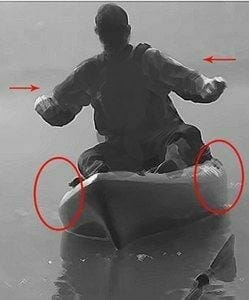
Try moving the kayak from side to side. Don’t be afraid to tip it over.
Cold water temperatures are around 40°. I recommend testing your kayak’s stability in water at least 70 or 75 degrees.
Kayak Stability and Design
When considering kayak stability and design, two primary factors come into play:
- Width of the Boat: Wider boats are often designed for standing and fishing. They offer a very stable platform. On the other hand, a narrower boat can still be plenty stable, just not stable enough for standing.
- The trade-off for a wider boat is speed. A narrower boat is typically faster but not as stable. However, a wider, slower boat is ideal for fishing while standing.
- Hull Design: Faster boats typically have a hull resembling a block shape, not the three rectangular lines seen on wider ones.
- Most wide boats have two circular shapes that dip down and meet in the middle, providing substantial stability when you lean to one side.
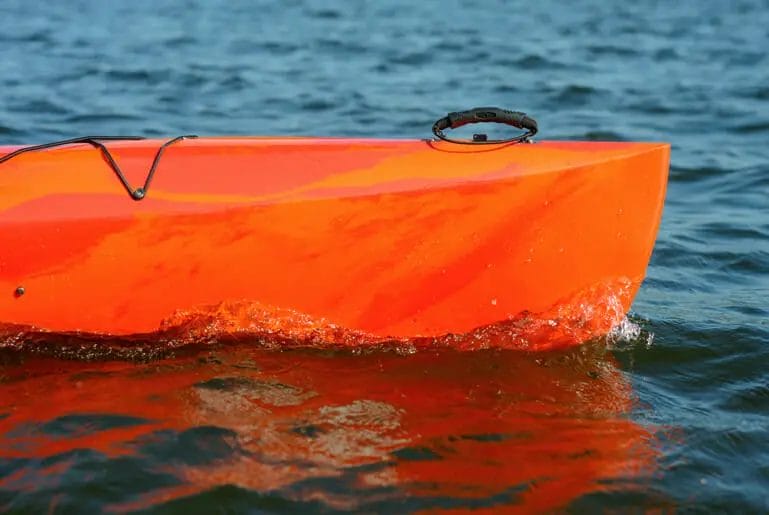
Practicing Boat Flip in Kayak Fishing Classes
When teaching kayak fishing classes, one of the most effective exercises we conduct for our students is intentionally flipping the boats. Here’s the process:
- Remove all gear from the boat to prevent any damage.
- Ensure you’re in deep enough water to prevent injuries when you flip your boat.
- Get rid of the paddle.
- Lean the boat to one side, then pull back when you feel scared. Repeat this a few times on each side to understand your kayak’s tipping point.
There’s a growing trend in fishing kayaks: they’re becoming wider, larger, and more stable. But beware of the stability overkill that comes with wider boats.
While wider boats allow you to stand up, if you’re not doing this often or if you value speed, you don’t need a super-wide, slow boat.
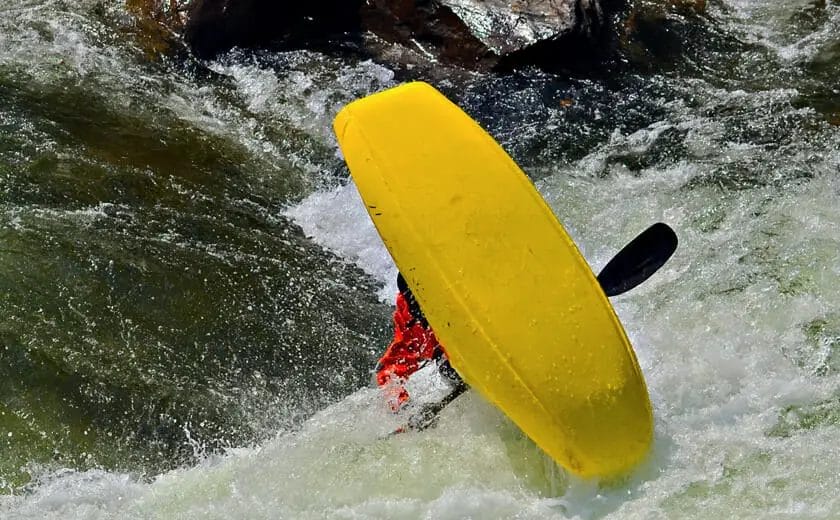
Practicing your wet reentry into the boat at this time is also highly beneficial. Some kayak anglers may not feel secure enough to stand in their kayaks. A wide boat is perfect for them as it’s designed specifically for that purpose.
If you’re not using your wider kayak for standing up, you’re missing out on the advantages of a broader view for fishing.
The Importance of Proper Weight Distribution
One factor that can significantly influence the stability of your kayak is how you distribute weight within it. Proper weight distribution can enhance the kayak’s balance, making it more stable and easier to control.
Front-to-Back Balance
Your kayak’s front-to-back balance, known as its trim, affects speed and stability.
If the nose of your kayak (the bow) is too heavy, it will plow through the water, reducing your speed and making it harder to steer.
If the tail (the stern) is too heavy, the nose will stick out of the water, catching the wind and making the kayak unstable and difficult to control.
For optimal performance and stability, aim for an even distribution of weight along the length of the kayak.
This usually means placing heavier items toward the middle of the boat.
Side-to-Side Balance
An uneven side-to-side (or lateral) weight distribution can also impact stability, causing the kayak to lean or list to one side.
This not only makes the kayak harder to control but also makes it more prone to capsizing.

Try to distribute weight evenly from side to side. When loading gear into your kayak, place heavier items directly in the center, then balance out lighter items on either side.
Consider the weight difference between paddlers if you’re paddling a tandem kayak. You may need to adjust seat positions or gear stowage to maintain balance.
Weight Distribution and Your Body Position
Remember, your body is the heaviest thing in your kayak, and how you position yourself can greatly affect the boat’s balance. Sitting up straight and centering your weight allows for better stability and control.
Leaning too far to one side can destabilize the kayak and increase the risk of capsizing.
Changes in Weight Distribution During the Trip
Keep in mind that weight distribution can change during your trip. Provisions, catching fish, or gathering items can change your kayak’s balance. You’ll need to adjust your gear placement or body position to maintain proper weight distribution.
Proper weight distribution is crucial for maximizing stability, control, and efficiency in a kayak. Learning to manage weight distribution effectively will enhance your paddling skills and make your outings more enjoyable and safer.
Techniques for Enhancing Stability
Understanding Lower and Upper Body Separation:
One of the key aspects of staying stable in a kayak is to understand the concept of lower and upper body separation. This means that the lower half of your body (your hips and legs) should be moving in sync with the kayak, while the upper half of your body (your torso, arms, and head) remains as still and upright as possible. Your lower body needs to “feel” the motion of the kayak and respond accordingly without transferring this motion to your upper body.
Proper Paddle Strokes:
Proper paddle strokes not only propel your kayak forward but also help to maintain balance. Good forward stroke technique requires rotation of the torso, which engages your core muscles, and this in turn enhances stability. Sweep strokes can help turn your kayak without leaning, increasing stability. The low brace turn stroke is also a good stroke for turning while maintaining stability, as it allows you to place your paddle flat on the surface of the water, creating additional support.
Bracing Techniques:
Bracing is a technique used to prevent a capsize. There are two main types of braces – high and low. A low brace is used when you feel yourself beginning to tip; you lower your paddle to the water on the side where you’re tipping, push down on the water and right yourself. A high brace is similar but used in more extreme tipping situations; the paddle is brought up high and you push down forcefully. Practicing these bracing techniques can significantly enhance your kayak’s stability.
Leaning into Turns:
Contrary to what might feel intuitive, leaning into turns (also known as edging) can actually increase your stability. By shifting your weight towards the inside of the turn, you use the buoyancy of the kayak to help you turn more efficiently. This requires good control of your lower body and core muscles, as you don’t want to lean too far and capsize.
Using Your Core:
Your core muscles, which include your abdominals, lower back, and sides, are key to maintaining balance in a kayak. Strong core muscles allow for better control of the kayak and more effective paddle strokes, which helps maintain stability. Core-strengthening exercises can significantly improve your kayaking technique.
Relaxing Your Body:
When you’re tense, your movements can become abrupt and uncontrolled, which can destabilize the kayak. By keeping your body relaxed, especially your hips, you can more easily move with the motion of the kayak, improving stability.
Proper Seating and Foot Position:
Your position in the kayak can have a big impact on its stability. You should sit up straight with your back supported by the seat, and your feet should be positioned against the foot pegs, knees slightly bent and outward, bracing against the cockpit of the kayak. This position allows you to control the tilt of the kayak using your hips, enhancing stability.
Stability in Different Types of Kayaks
There’s a broad range of kayak designs, and each type has its own unique stability characteristics. Let’s delve into how stability factors into different types of kayaks:
Recreational Kayaks:
Recreational kayaks are typically designed for casual use like paddling around calm lakes, slow-moving rivers, and calm coastal waters. These kayaks tend to be wider and shorter, offering good initial stability. They are great for beginners and those who prioritize stability and ease of use over speed and maneuverability.
Touring Kayaks:
Touring or sea kayaks are designed for longer trips on open water. These are typically longer and narrower, which can make them feel less stable initially (less initial stability), but they have excellent secondary stability. This means they can lean quite a bit without capsizing, which is useful in choppy water or when making sharp turns. Their design is aimed at efficient travel, so they’ll track straight and cover distances with less effort than a recreational kayak.
Sit-on-Top Kayaks:
Sit-on-top kayaks are very user-friendly and are great for beginners and recreational paddlers. They offer excellent initial stability and are easy to get on and off, especially if you capsize. Because of their wide hulls, they are typically quite stable and are a favorite among leisure paddlers, anglers, and photographers.
Whitewater Kayaks:
Whitewater kayaks are short and designed for maneuverability rather than tracking. They may feel unstable to novice paddlers due to their rounded bottoms, which allows for quick turns and the ability to tilt and not flip over in turbulent waters (high secondary stability).
Fishing Kayaks:
Fishing kayaks, which can be sit-on-top or sit-inside, are designed with stability as a prime factor to allow anglers to cast and even stand up without capsizing. These kayaks are typically wider and may have pontoon-like hulls for added stability. Some models even come with outriggers to further increase stability.
Inflatable Kayaks:
Inflatable kayaks offer decent stability, largely dependent on their design. They sit high on the water and have wide hulls, which helps with initial stability. They are perfect for leisurely paddling trips and for those who have limited storage space. However, they might not perform as well in windy conditions or choppy waters.
Tandem Kayaks:
Tandem kayaks, designed for two paddlers, have long hulls that provide good tracking and stability. The distribution of two paddlers’ weight helps to stabilize the kayak, but coordinated efforts are necessary for maneuvering.
Remember, a kayak’s stability is greatly influenced by its design. The shape and width of the hull, the length of the kayak, the type and position of the seats, all play a role in how stable the kayak will feel on the water. It’s always a good idea to try a few different types to see what feels most comfortable and suits your needs best.
Equipment for Enhanced Stability
In addition to selecting a well-designed kayak and honing your paddling skills, several pieces of equipment can enhance your kayak’s stability.
These items can be particularly beneficial for beginners or those using a kayak for activities requiring extra balance, like fishing or photography.
Here are some examples:
Kayak Stabilizers
Also known as kayak outriggers, stabilizers are devices you attach to your kayak to increase its buoyancy, making it harder to tip over.
They’re usually made of a float (similar to a mini kayak hull) attached to an arm that extends from the kayak.
Some stabilizers are retractable, allowing you to pull them out of the water when you don’t need them. Stabilizers can be particularly useful for beginners or activities that require a lot of movement on the kayak, like fishing.
Kayak Skegs and Rudders
Skegs and rudders are devices you can use to help steer your kayak and keep it tracking in a straight line, contributing to stability.
A skeg is a retractable fin located at the stern (back) of the kayak, while a rudder is a hinged blade located at the stern that can be turned from side to side.
Both devices help with tracking, particularly in windy conditions or strong currents.
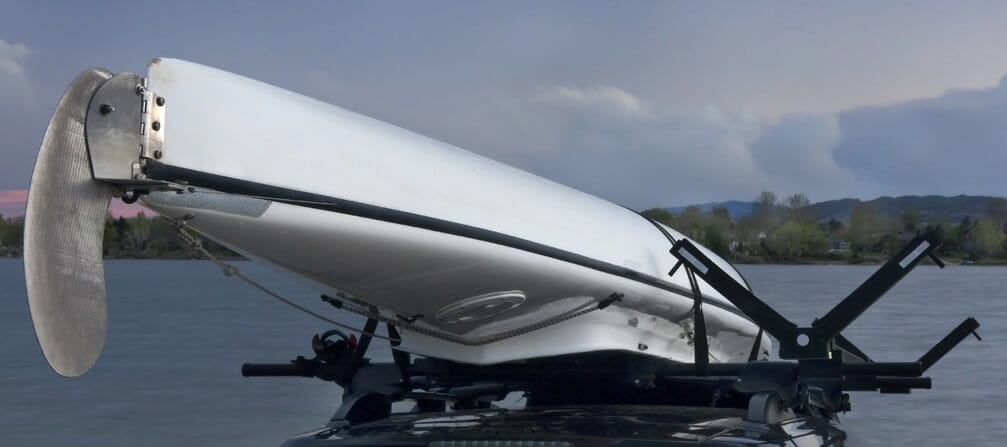
Proper Seat and Footrest Adjustment
While not necessarily “equipment” in the same way as stabilizers or skegs, properly adjusting your seat and footrests can greatly affect your kayak’s stability.
Your seat should be adjusted so that you’re sitting upright or slightly leaned back, allowing you to use your torso to paddle efficiently.
Your footrests should be adjusted so your knees slightly bend, allowing you to brace against the kayak for more control and stability.
Balanced Load Distribution
Even the way you load your kayak with gear can affect its stability.
Heavier items should be loaded as low and close to the kayak’s center as possible to help lower its center of gravity and increase its stability.
If you carry a lot of gear, it should be evenly distributed from side to side and from front to back.
Using this equipment and techniques effectively can significantly increase your kayak’s stability, making your paddling experience more enjoyable and safer.
The Influence of Weather and Water Conditions
While your skill and equipment play significant roles in maintaining stability, you must also know how weather and water conditions can impact your kayaking experience.
Wind
The wind is one of the most influential factors in kayak stability. Gusts can catch the side of your kayak, causing it to tilt or become unstable, especially if the wind direction changes frequently.
Strong winds can also generate waves, which can further compromise stability. If you’re caught in windy conditions, try to position your kayak to face the wind as much as possible. This will provide the greatest stability and control.
Currents
Water currents can also dramatically impact your kayak’s stability. A strong current can sweep your kayak off course or cause it to tip. Be aware of the direction of the current and plan your paddling accordingly.
If you’re paddling in tidal waters, understand the tide schedule and how the changing tides affect the water currents.
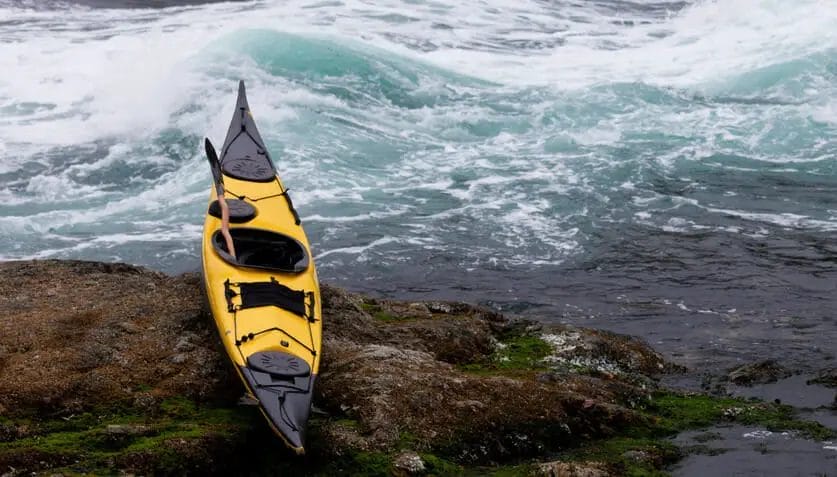
Waves and Chop
Choppy water or large waves can make maintaining balance in your kayak difficult. Waves hitting your kayak from the side can cause it to rock dangerously.
Learning to brace against waves and maintain your balance in choppy conditions is a key skill.
Temperature
Extreme hot and cold temperatures can influence your experience and stability in a kayak. In hot weather, dehydration can impair your balance and strength. Always have enough water with you, and consider a sunshade for your kayak in extreme heat.
On the other hand, cold weather could lead to hypothermia if you capsize and aren’t dressed properly for the conditions. Always dress appropriately for the temperature, even if you don’t plan to go in the water.
Visibility
Fog, rain, or even the glare of the water can reduce visibility, making it harder to see waves or other hazards in time to react and maintain stability. Always carry navigation aids like a compass or GPS, and consider using a spray skirt to keep rain or splash out of your kayak.
Understanding the influence of weather and water conditions on your kayak’s stability is crucial. While you can’t control the weather, you can prepare for it, improving your safety and enjoyment on the water.
